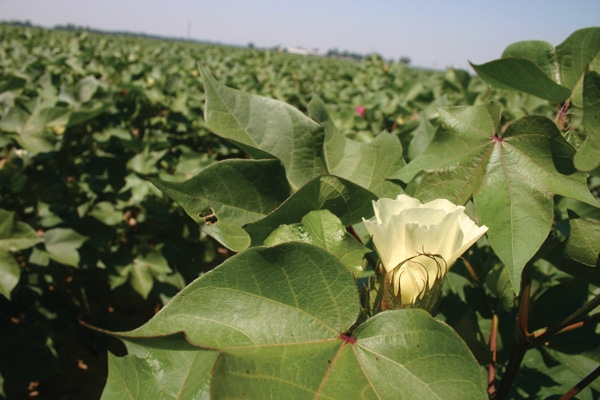March 11, 2011

Oklahoma State University Extension cotton specialists are giving growers timely information on controlling horseweed in limited-till and no-till cotton and on how to find substitutes for the insecticide Temik.
This information and much more can be found in Cotton Comments, a new cotton newsletter created by the Southwest Research and Extension Center in Altus.
OSU's 2010 Extension Cotton Report is available and contains summaries of various Extension applied research trials, many conducted in producer fields.
Information on horseweed control can be found online at www.ntokcotton.org and http://osu.altus.us/.
Shane Osborne, Extension associate specialist, says: "Due to the lack of tillage in limited-till and no-till cotton farming, producers often get an increase in winter and spring weed problems such as horseweed, Russian thistle and kochia. Preplant burndown herbicides are essential to replace tillage to control weeds.
"Russian thistle control research by Dr. Wayne Keeling on the High Plains has shown Paraquat (Gramoxone Inteon, Firestorm and Parazone, etc.) has shown excellent control of Russian thistle but not horseweed. In Oklahoma, glyphosate applied alone has proven very inconsistent on horseweed. Recent confirmation of glyphosate resistant horseweed in Oklahoma points out the need for additional sources of control.
"Oklahoma research shows effective horseweed control can be accomplished by including Dicamba (Banvel, Clarity, etc.) or 2, 4-D with glyphosate. It is important to remember weed size at time of application is critical. Excellent control of horseweed has been seen when applications were made to horseweed in the rosette state (flat or prostrate, prior to bolting or vertical growth).
"Remember plant back restrictions apply for both Dicamba and 2, 4-D. When using Dicamba, planting may occur 21 days after an application as long as one-inch of rainfall has been received within that time. In addition, Dicamba is not recommended for use in areas receiving less than 25 inches of annual rainfall. Studies show planting may take place 30 days after applications of 2, 4-D without crop injury or yield reduction.
"Sharpen is a new product from BASF. It provides both burndown and residual control on many broadleaf weeds. Sharpen applied to horseweed in the rosette stage when tank-mixed with one ounce per acre of either glyphosate, Dicamba or 2, 4-D has provided excellent control.
“Sharpen's label states 42 days and one-inch of rainfall must occur after application before cotton can be planted—that is for applications at one ounce per acre. Recommended adjuvants with Sharpen are MSO (methylated oil) or crop oil concentrate along with ammonium sulfate. Substituting other adjuvants is not recommended and will reduce Sharpen's effectiveness. Sharpen has restrictions on coarse soil use. Cotton injury can occur on coarse soils with less than 1.5 percent organic matter. Also, Sharpen's label states it should not be used in areas where an at-planting application of an organophosphate or carbamate insecticide is planned or severe injury can result.
"Since Sharpen is new to the market, it can't be called a standard yet. Results so far suggest it can help growers control horseweed in limited or no-till cotton. Several years of information qualify the inclusion of one-quarter pound active ingredient per acre of Dicamba or one pound active ingredient per acre of 2,4-D, with the usual one pound active ingredient per acre of glyphosate as standards for horseweed control."
Temik availability may be severely limited for the 2011 cotton planting season, according to the new OSU Extension newsletter. Terry Pitts, Extension Southwest District area entomology specialist, reports: "Temik in-furrow granules are not being produced due to a stop manufacturing court order. The product will be limited to what was in storage prior to a February court order. This will create demand for other products this season. Methods of protecting seedling cotton include in-furrow granules and seed treatments as well as foliar sprays at crop emergence.
"In-furrow granules include Temik 15G and Thimet 20G; it is possible Thimet will be the only product available at planting. Thimet has not worked as well as Temik and it doesn't have activity against nematodes. Thimet should be applied as a T-band to prevent contact with the seed, avoiding germination issues.
“Seed treatment also offers insect and nematode control. Insecticide control of thrips is available in Gaucho Grande and Cruiser. If insect and nematode control is needed, then Aeris and Avicta are available. These products can be applied by your seed company or local chemical distributors.
"Foliar sprays can be used to control thrips but have no nematode activity. Products available for foliar sprays are Bidrin, Dimethioate (Cygon), Centric, Orthene and Phaser.
"Nematode control products include Temik, Telone LL and Vydate CLV. Telone LL has been used in the vegetable industry due to higher cost and need for application equipment. It is applied prior to planting.
"Recent trials at the University of Arizona with precision agricultural technology have provided control with fewer products used per acre. This technology makes application only to the areas of the field with damaging levels of nematodes. The result lowers the chemical cost per acre. Vydate CLV is applied as a foliar spray following the use of an in-furrow treatment such as Temik or a soil fumigant like Telone LL. This will help improve performance on Lance, Reniform and Root-knot nematodes."
You May Also Like




